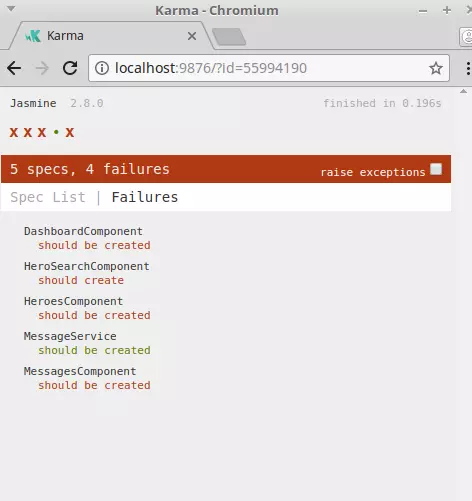Home >Web Front-end >JS Tutorial >Angular Testing: A Developer's Introduction
Angular Testing: A Developer's Introduction
- Joseph Gordon-LevittOriginal
- 2025-02-15 11:44:12686browse
This guide explores automated testing in Angular 5 projects, covering unit and end-to-end testing. Angular's built-in testing capabilities, accessible via the Angular CLI or quick start project, are central.

This guide provides a foundational understanding. A comprehensive treatment would require a much lengthier resource.
Key Concepts:
- Angular Testing Fundamentals: Angular 5 projects include automated testing features using the Angular CLI or quick start.
-
Testing Technologies:
TestBed(configuring test modules), Jasmine (writing tests), Karma (browser test execution), and Protractor (end-to-end testing) are key technologies. -
Unit Testing Components: Components are tested in isolation or within the Angular environment to assess template and dependency interactions.
TestBedand asynchronous utilities facilitate this. -
Testing with Dependencies: For components relying on other components, services, or modules,
TestBedneeds mock services or schemas likeNO_ERRORS_SCHEMAfor isolation. - End-to-End Testing: Protractor simulates user actions in a real browser, verifying application functionality.
-
Code Coverage: Tools like Karma's
coverageIstanbulReportergenerate reports showing the extent of test coverage. -
Supplementary Tools:
ng lint(code linting) and Visual Studio Code (intelligent code editing) enhance code quality and consistency.
Prerequisites: A strong grasp of Angular 4 fundamentals and familiarity with automated testing concepts are assumed. This guide uses Angular 5.2. Example code is available (link to GitHub repository would go here).

Testing Technologies:
-
Angular Testing Utilities: Classes and functions for building test environments (primarily
TestBedfor configuring test modules). Example:
<code class="language-typescript">TestBed.configureTestingModule({
imports: [ RouterTestingModule ],
declarations: [ DashboardComponent ],
schemas: [ NO_ERRORS_SCHEMA ],
providers: [
{
provide: HeroService,
useClass: MockHeroService
}
],
})
.compileComponents();</code>
- Jasmine: The testing framework using behavior-driven notation. Example:
<code class="language-typescript">describe('createCustomer', () => {
it('should create new customer', (customer) => {
// ...assertions...
});
// ...more tests...
});</code>
-
Karma: Executes tests in a browser environment, displaying results in the command line and browser. Configuration is in
karma.conf.js. Example configuration snippet:
<code class="language-javascript">module.exports = function (config) {
config.set({
// ...configuration details...
browsers: ['Chrome'],
// ...more configuration...
});
};</code>
-
Protractor: An end-to-end testing framework for Angular, simulating user interactions in a real browser. Configuration is in
protractor.conf.js.
Unit Testing:
Running ng test executes tests. The guide then details how to address common issues like testing components with dependencies (other components, modules, services) using techniques like mocking or NO_ERRORS_SCHEMA. The example shows how to test components that utilize FormsModule and RouterTestingModule. Testing components that use services is addressed, demonstrating the creation of mock services to isolate unit tests.
Service Testing: The guide provides an example of testing a service that interacts with HttpClientModule, using HttpTestingController to control requests and responses, creating various test scenarios.
End-to-End Testing: The guide introduces end-to-end testing with Protractor, showing how to create helper functions (e.g., in app.po.ts) and write e2e tests (e.g., in app.e2e-spec.ts). An example demonstrates testing navigation and verifying displayed text.

Code Coverage: The guide explains how to generate code coverage reports using ng test --watch=false --code-coverage, and how to configure coverage thresholds in karma.conf.js.

Additional Utilities: The guide recommends using ng lint for code linting and Visual Studio Code for its intelligent code editing features (Intellisense, error highlighting, Angular extensions). The benefits of Continuous Integration (CI) are also mentioned.

When to Write Tests: The guide concludes by discussing when it's appropriate to write tests (after prototyping, with sufficient funding) and the benefits of test-driven development (TDD). It emphasizes the importance of testing for production-ready applications. A FAQ section addresses common questions about Angular testing.
The above is the detailed content of Angular Testing: A Developer's Introduction. For more information, please follow other related articles on the PHP Chinese website!
Related articles
See more- An in-depth analysis of the Bootstrap list group component
- Detailed explanation of JavaScript function currying
- Complete example of JS password generation and strength detection (with demo source code download)
- Angularjs integrates WeChat UI (weui)
- How to quickly switch between Traditional Chinese and Simplified Chinese with JavaScript and the trick for websites to support switching between Simplified and Traditional Chinese_javascript skills

